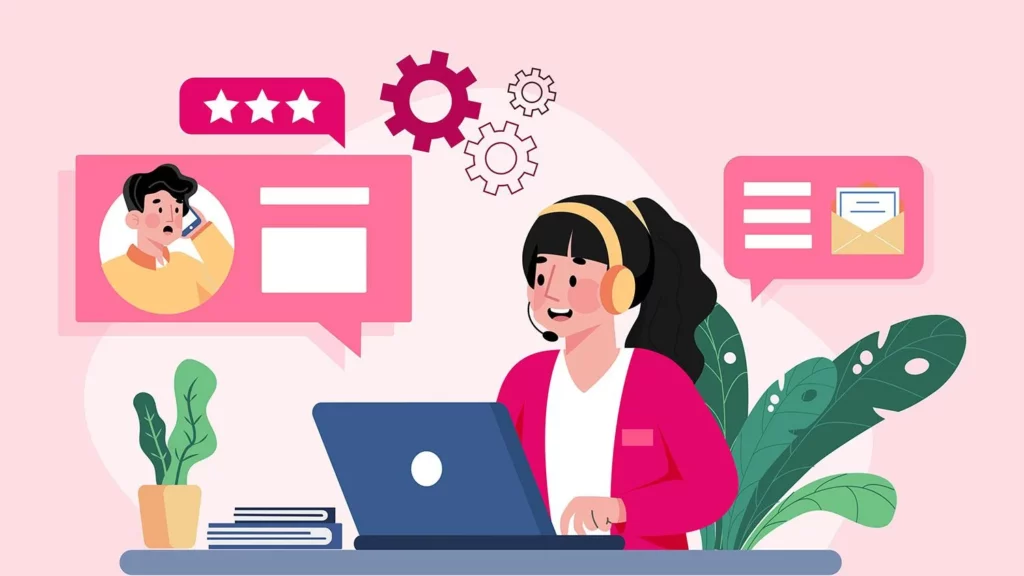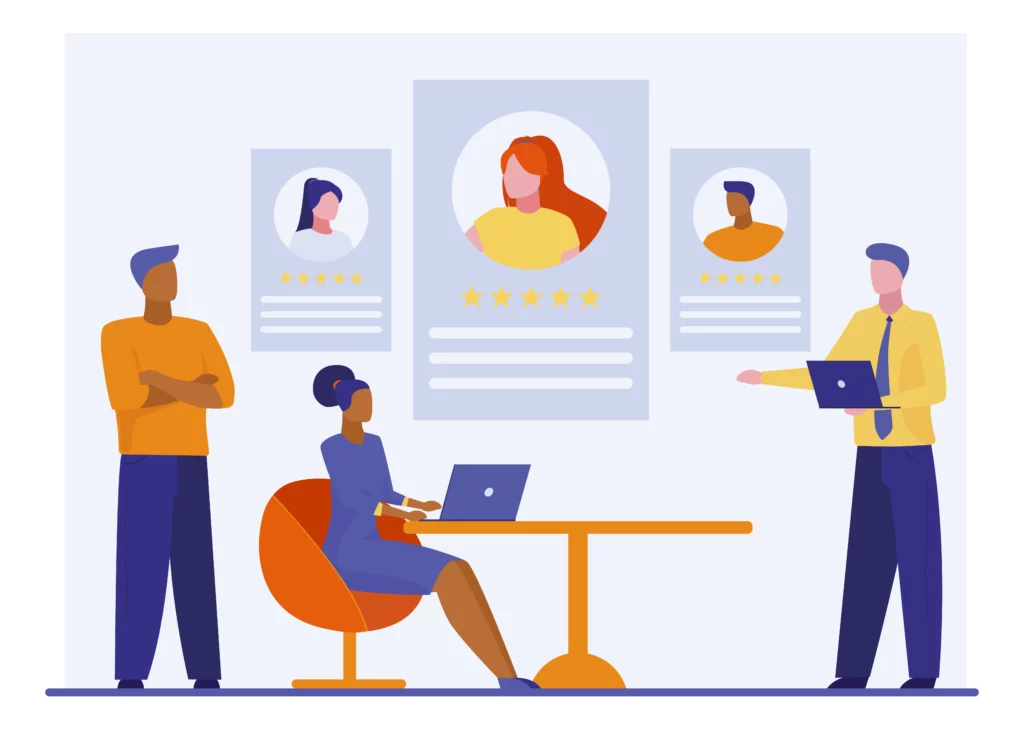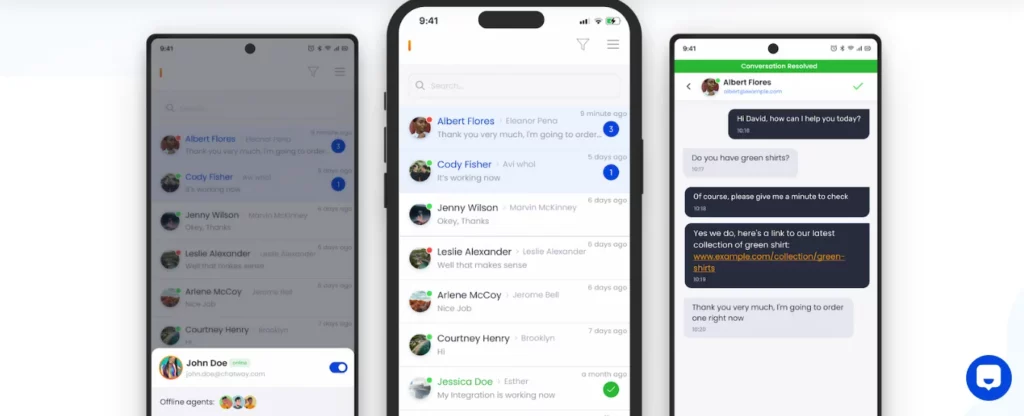
Damilola Oyetunji
Content Writer at Chatway.
Quickly respond to customer and visitor inquiries via live chat
Personalize the chat widget to match your business's style and branding
Stay updated on all incoming messages with email and push notifications
Improve the way your team works with chat assignments and private notes
Provide support on the go with Chatway's mobile apps for iOS and Android devices
Categorize and label conversations using specific criteria for personalized support
Interact with visitors in their preferred language, supporting 20+ languages
Use Chatway live chat on multiple platforms such as Shopify, Wix, Duda etc
Get insights into your support activities to better understand customer interactions
Centralize chats from Messenger and email into a single dashboard
Live Chat,Support - 18 Mins READ
Content Writer at Chatway.

Gone are the days of customers waiting on hold for phone support or navigating long email chains. Live chat now offers a convenient and immediate way for you to connect with customers, fostering stronger relationships and driving growth. However, if not used properly, you could lose customers and sales.
To help you avoid making costly mistakes, we’ve written this blog post to outline 9 common mistakes businesses make with live chat, along with actionable steps to avoid them. Let’s get started!

While live chat for businesses offers incredible benefits, businesses can easily fall victim to common mistakes that hinder its effectiveness. Here’s how to avoid these pitfalls and leverage live chat to its full potential:
Failing to promptly respond to customer inquiries can have detrimental effects on customer satisfaction and engagement. When customers are left waiting for a response, they may experience frustration, impatience, and dissatisfaction with the service. Slow response times can also result in missed opportunities for sales or conversions, as customers may abandon their carts or seek assistance elsewhere.
1. Customer frustration: Long wait times for a response in live chat can lead to frustration and dissatisfaction among customers, diminishing their overall experience with your brand.
2. Increased cart abandonment: Customers who encounter delays may abandon their shopping carts out of frustration or impatience, leading to lost sales and revenue opportunities.
3. Negative brand perception: Slow response times reflect poorly on your brand’s commitment to customer service and responsiveness, potentially damaging your reputation and credibility.
4. Decreased customer loyalty: Unsatisfactory experiences due to slow response times can erode customer trust and loyalty, leading to decreased retention and repeat business.
Set clear response time expectations on your chat window and ensure adequate staffing levels to manage chat volume during peak hours.
1. Establish response time targets: Clearly communicate response time expectations to customers by displaying estimated wait times or response time guarantees on your chat window. Set realistic targets based on your team’s capacity and workload.
2. Prioritize staffing during peak hours: Anticipate high chat volumes during peak hours and ensure that you have sufficient staff available to manage incoming inquiries promptly. Adjust staffing levels as needed to meet demand and prevent long wait times.
3. Optimize agent efficiency: Equip agents with tools and resources to streamline their workflow and respond to inquiries more efficiently. Provide training on effective multitasking, keyboard shortcuts, and utilizing canned responses to expedite responses.
4. Monitor and analyze performance: Regularly monitor response times and chat volume data to identify trends, bottlenecks, and areas for improvement. Use insights from performance analysis to optimize staffing levels, adjust response time targets, and refine chat management strategies.
Deploying unprepared agents in live chat interactions poses a significant risk to the quality of customer service provided. When agents lack adequate training, product knowledge, or essential communication skills, they may struggle to address customer inquiries effectively, leading to frustration, dissatisfaction, and a negative perception of the brand. Unprepared agents are also more prone to errors, misunderstandings, and miscommunication, further exacerbating the customer experience.
1. Poor customer satisfaction: Customers expect knowledgeable and competent assistance when engaging with live chat support. Unprepared agents may fail to meet these expectations, resulting in low satisfaction levels and negative feedback.
2. Increased resolution times: Agents lacking proper training and product knowledge may take longer to address customer inquiries or resolve issues, prolonging the duration of chat interactions and increasing customer frustration.
3. Damage to brand reputation: Negative interactions with unprepared agents can tarnish the reputation of the brand, as customers may associate subpar support experiences with the overall quality and reliability of the business.
4. Loss of customer trust: Incompetent or unprofessional interactions with unprepared agents erode customer trust and confidence in the brand, potentially leading to decreased loyalty and retention.

Invest in proper training for live chat agents. This includes product knowledge, communication skills, and active listening techniques.
1. Comprehensive onboarding program: Develop a structured onboarding program for new live chat agents that covers essential topics such as product knowledge, company policies, communication skills, and chat platform training.
2. Product knowledge training: Provide in-depth training on the products or services offered by the business, including features, benefits, pricing, and troubleshooting procedures. Ensure that agents have a thorough understanding of the products to confidently assist customers and address inquiries.
3. Communication skills development: Offer training in effective written communication skills, including grammar, spelling, tone, and language etiquette. Teach agents how to write clear, concise, and professional responses that resonate with customers and convey empathy and understanding.
4. Active listening techniques: Train agents in active listening techniques to better understand customer needs, preferences, and concerns. Encourage agents to ask clarifying questions, paraphrase customer inquiries, and demonstrate empathy and attentiveness in their interactions.
5. Role-playing exercises: Conduct role-playing exercises and mock scenarios to simulate real-life chat interactions and provide hands-on practice for agents. Use feedback and coaching to reinforce positive behaviors and address areas for improvement.
6. Continuous learning and development: Offer ongoing training opportunities and resources to support the continuous learning and development of live chat agents. Provide access to knowledge bases, training materials, and refresher courses to keep agents updated on product updates, industry trends, and best practices in customer service.
7. Performance evaluation and feedback: Regularly assess agent performance based on key performance indicators (KPIs) such as response times, customer satisfaction scores, and resolution rates. Provide constructive feedback and coaching to help agents improve their skills and performance over time.
Customers expect personalized interactions, not generic scripts. Sending robotic responses can make customers feel unheard and undervalued. This lack of personalization undermines the rapport between the customer and the business, leading to dissatisfaction and potentially loss of business.
1. Decreased customer satisfaction: When customers receive generic responses that do not address their specific needs or concerns, they may feel like just another number in a queue rather than valued individuals.
2. Loss of trust: Generic responses can erode trust in the brand as customers perceive the business as indifferent or insincere in its interactions.
3. Increased churn: Frustrated by impersonal interactions, customers may seek alternatives that offer more personalized and attentive service, leading to higher churn rates.
Empower your agents to personalize interactions. Encourage active listening to understand customer needs and tailor responses accordingly.
1. Train agents in active listening: Teach your agents to actively listen to customers, paying attention to their specific inquiries, concerns, and emotional cues. This enables agents to provide responses that are relevant and empathetic.
2. Provide guidelines, not scripts: Instead of rigid scripts, offer guidelines and frameworks for agents to follow while maintaining flexibility to adapt responses based on the unique context of each interaction.
3. Encourage empathy and rapport-building: Emphasize the importance of building rapport with customers by expressing empathy and understanding. Encourage agents to use the customer’s name and reference previous interactions to demonstrate attentiveness and continuity.
4. Utilize customer data: Leverage customer data and history to personalize interactions. Use information such as past purchases, preferences, and previous interactions to tailor responses and recommendations to each customer’s individual needs.
5. Offer proactive assistance: Anticipate customer needs and offer proactive assistance before they even ask. Proactively reaching out with relevant information or solutions demonstrates proactive customer service and enhances the perception of personalization.
6. Implement feedback mechanisms: Encourage customers to provide feedback on their interactions with live chat agents. Use this feedback to identify areas for improvement and refine agent training and processes accordingly.
7. Empower agents to escalate complex issues: Equip agents with the authority and resources to escalate complex issues to higher-level support or management when necessary. This ensures that customers receive timely and effective resolutions, even for challenging issues.
Restricting live chat availability creates a barrier for customer communication. When customers encounter limited availability of live chat support, it hampers their ability to reach out for assistance when they need it most. This can lead to frustration, dissatisfaction, and potentially lost opportunities for engagement or sales.
1. Missed opportunities: Customers may abandon their inquiries or transactions if they cannot access live chat support during their preferred hours, resulting in missed opportunities for engagement or sales.
2. Decreased customer satisfaction: Limited availability can frustrate customers who expect immediate assistance, leading to negative experiences and decreased satisfaction with your brand.
3. Competitive disadvantage: Businesses that offer 24/7 live chat support gain a competitive edge by providing round-the-clock assistance, while those with restricted availability may lose customers to competitors with more accessible support options.
Analyze website traffic patterns and customer behavior to determine optimal chat hours. Offer extended availability when possible.
1. Data-driven analysis: Utilize website analytics tools to track visitor traffic patterns and identify peak hours of activity when customers are most likely to engage with live chat support. Analyzing this data helps determine the optimal hours for offering live chat assistance.
2. Customer feedback: Solicit feedback from customers regarding their preferred hours for accessing live chat support. Use this feedback to align chat availability with customer expectations and preferences.
3. Implement flexible scheduling: Offer extended live chat availability during peak hours of customer activity, as well as during evenings, weekends, and holidays to accommodate diverse customer schedules and time zones.
4. Prioritize high-traffic periods: Allocate additional resources and staffing during high-traffic periods to ensure prompt response times and minimize wait times for customers seeking live chat assistance.
5. Seamless handoffs: Implement seamless handoff procedures between live chat and other support channels (e.g., email or phone) during periods of limited availability to ensure continuity of support and prevent customer frustration.
6. Communicate availability clearly: Clearly communicate the hours of live chat availability on your website, including any limitations or exceptions, to manage customer expectations effectively.
Neglecting negative feedback received through live chat can have detrimental effects on brand reputation and erode customer trust. When negative feedback is left unaddressed, it signifies to customers that their concerns are not valued, potentially leading to increased dissatisfaction and a tarnished brand image.
1. Diminished brand reputation: Ignoring negative feedback can result in a perception of indifference or negligence on the part of the business, damaging its reputation among existing and potential customers.
2. Decreased customer loyalty: Customers who feel their concerns are dismissed or ignored are less likely to remain loyal to the brand, leading to higher churn rates and decreased customer lifetime value.
3. Amplification of negativity: Unaddressed negative feedback can spread rapidly through word-of-mouth and online reviews, amplifying the negative perception of the brand and dissuading others from engaging with it.
4. Missed opportunities for improvement: Ignoring negative feedback means missing out on valuable insights into areas of weakness or areas for improvement within the business, hindering its ability to grow and evolve.

Develop a system for promptly addressing negative live chat feedback. Acknowledge the customer’s concern, apologize for the issue, and take steps to resolve it.
1. Implement feedback monitoring: Utilize tools and systems to monitor live chat interactions in real-time and flag instances of negative feedback or customer dissatisfaction.
2. Assign responsibility: Designate specific team members or departments responsible for monitoring and addressing negative feedback received through live chat.
3. Acknowledge and empathize: When responding to negative feedback, acknowledge the customer’s concerns and express empathy for their experience. Let them know that their feedback is valued and taken seriously.
4. Apologize and take ownership: Take responsibility for any mistakes or shortcomings that led to the negative experience, and offer a sincere apology to the customer.
5. Resolve the issue: Work swiftly to address the customer’s concerns and find a resolution to the issue at hand. This may involve offering compensation, providing a refund or exchange, or implementing corrective measures to prevent similar issues from recurring in the future.
6. Follow up: After resolving the issue, follow up with the customer to ensure their satisfaction and reinforce your commitment to providing excellent customer service.
7. Use feedback to drive improvement: Analyze patterns and trends in negative feedback to identify underlying issues or areas for improvement within the business. Use this feedback to inform strategic decisions and initiatives aimed at enhancing the customer experience.
Failure to leverage chatbots effectively can result in missed opportunities for streamlining customer interactions and optimizing agent workflows. While chatbots are not meant to replace human interaction entirely, underutilizing them can lead to inefficient agent workloads and hinder overall customer service efficiency.

1. Increased agent workload: Without the support of chatbots, agents may become overwhelmed by routine tasks and repetitive inquiries, leading to decreased productivity and higher stress levels.
2. Longer response times: Human agents may be tied up with simple tasks, causing delays in responding to more complex inquiries and reducing overall responsiveness to customer needs.
3. Inefficient resource allocation: Failing to leverage chatbots effectively means missing out on the opportunity to automate repetitive tasks, resulting in suboptimal allocation of resources and increased operational costs.
4. Inconsistent customer experiences: Inconsistencies in response times and service quality may arise when agents are bogged down by menial tasks, leading to variations in the customer experience and potential dissatisfaction.
Implement chatbots to automate simple tasks like greetings, lead qualification, and answering frequently asked questions (FAQs). This frees up agents to handle more complex inquiries, improving efficiency and enhancing the overall customer experience.
1. Identify automation opportunities: Analyze common customer inquiries and interactions to identify tasks that can be automated using chatbots, such as greeting visitors, qualifying leads, providing basic product information, and answering FAQs.
2. Develop a chatbot strategy: Define clear objectives and use cases for chatbot implementation, ensuring alignment with business goals and customer needs. Determine the roles and responsibilities of chatbots versus human agents in customer interactions.
3. Continuously optimize chatbot performance: Monitor chatbot interactions and gather feedback to identify areas for improvement and refine chatbot responses over time. Regularly update chatbot scripts and algorithms to enhance accuracy and effectiveness.
4. Integrate chatbots with live chat platforms: Integrate chatbots seamlessly with live chat platforms to provide a unified customer service experience. Enable smooth handoffs between chatbots and human agents to ensure a seamless transition for customers when escalation is required.
Neglecting to track and analyze data related to live chat interactions can be a missed opportunity for businesses to gain valuable insights into their performance and make informed decisions for improvement. Without this important information, businesses may struggle to identify trends, pinpoint areas of weakness, or capitalize on strengths within their live chat support system.
1. Lack of performance visibility: Without tracking key metrics, businesses operate in the dark, unable to assess the effectiveness of their live chat support or measure its impact on customer satisfaction and business outcomes.
2. Inability to identify trends and patterns: Data analysis allows businesses to identify trends and patterns in customer behavior, preferences, and support needs, enabling them to tailor their live chat strategy accordingly and stay ahead of evolving customer expectations.
3. Missed opportunities for improvement: Without data-driven insights, businesses may miss out on opportunities to optimize their live chat performance, streamline workflows, and enhance the overall customer experience.
4. Risk of stagnation or decline: Failing to track and analyze data leaves businesses vulnerable to stagnation or decline, as they lack the necessary information to adapt to changing market dynamics, customer needs, and competitive pressures.
Monitor live chat metrics such as response times, resolution rates, and customer satisfaction ratings. Analyze this data to identify areas for improvement and optimize your live chat strategy.
1. Define key performance indicators (KPIs): Identify key live chat metrics that align with your business objectives and customer service goals, such as average response time, first contact resolution rate, customer satisfaction score (CSAT), and chat abandonment rate.
2. Implement tracking mechanisms: Utilize live chat software or analytics tools to track and record relevant data points from live chat interactions, including timestamps, agent performance, customer feedback, and chat transcripts.
3. Regularly review performance metrics: Establish a regular cadence for reviewing live chat metrics and performance reports to monitor trends, track progress over time, and identify any deviations from established benchmarks or targets.
4. Analyze data to identify insights: Use data analysis techniques to uncover patterns, trends, and correlations within your live chat data. Look for opportunities to improve efficiency, enhance customer satisfaction, and address recurring issues or pain points.
5. Act on insights to drive improvement: Translate insights gleaned from data analysis into actionable strategies and initiatives to optimize your live chat support. Implement changes, test hypotheses, and monitor outcomes to assess the effectiveness of interventions and iterate as needed.
6. Foster a culture of data-driven decision-making: Promote awareness and understanding of the importance of data analysis within your organization. Encourage cross-functional collaboration and knowledge sharing to leverage insights from live chat data across departments and teams.
Overlooking the significance of mobile devices in today’s digital era can be a costly oversight for businesses. With the majority of internet traffic now originating from mobile devices, failing to prioritize a mobile-friendly live chat experience can lead to alienating a significant portion of your audience. A non-responsive or poorly optimized live chat solution on mobile devices can result in frustration, reduced engagement, and ultimately, lost opportunities for customer interaction and conversion.

1. Decreased user engagement: A live chat interface that is not optimized for mobile devices may present usability issues such as small text, difficult navigation, or unresponsive buttons, discouraging users from engaging with the chat feature.
2. Negative perception of the brand: A subpar mobile experience can reflect poorly on the brand, conveying a message of technological ineptitude or disregard for user needs, potentially tarnishing the brand’s reputation and credibility.
3. Missed opportunities for customer interaction: With the prevalence of mobile browsing, businesses risk missing out on valuable opportunities to engage with customers in real-time if their live chat solution fails to meet the needs and expectations of mobile users.
4. Decreased conversion rates: A cumbersome or inaccessible live chat experience on mobile devices can impede the customer journey and deter users from completing desired actions such as making a purchase or requesting assistance, leading to lower conversion rates and lost revenue.
Ensure your live chat solution is fully responsive and optimized for mobile devices. This guarantees a seamless user experience for customers on the go.
1. Adopt a mobile-first approach: Design your live chat interface with mobile users in mind from the outset, prioritizing responsive design principles and user experience optimization for smaller screens and touch-based interactions.
2. Test across multiple devices and platforms: Conduct thorough testing of your live chat solution across a variety of mobile devices, operating systems, and browsers to ensure compatibility and functionality under different conditions.
3. Simplify the user interface: Streamline the user interface of your mobile live chat solution to minimize clutter, reduce load times, and prioritize essential features and functions for ease of use on mobile devices.
4. Optimize for touch interactions: Optimize the layout, spacing, and sizing of interactive elements within the live chat interface to accommodate touch-based interactions and ensure a fluid and intuitive user experience for mobile users.
5. Enable push notifications: Implement push notifications to alert users to new messages or chat requests even when they are not actively engaged with the live chat interface, enhancing responsiveness and encouraging timely interaction.
6. Provide offline access options: Offer alternative communication channels or self-service options for mobile users to access support or information when live chat is unavailable or offline, ensuring continuity of service and support across different touchpoints.
Overlooking the strategic promotion of your live chat feature can result in missed opportunities for customer engagement and support. If customers are unaware of its availability or location, they may resort to alternative, less efficient communication channels, leading to potential frustration and dissatisfaction. Without prominently showcasing your live chat option, you risk underutilizing a valuable tool for providing real-time assistance and fostering positive customer interactions.
1. Reduced customer engagement: Failure to effectively promote your live chat feature may result in lower utilization rates, as customers may be unaware of its existence or uncertain about its accessibility.
2. Increased reliance on less efficient channels: Customers who are unable to locate the live chat option may resort to phone calls, emails, or social media inquiries, leading to longer response times and potentially higher support costs.
3. Missed opportunities for proactive assistance: Without proactive promotion of the live chat feature, businesses may miss out on opportunities to engage with customers proactively and offer timely assistance during critical moments in their journey.
4. Perceived lack of availability: Customers may assume that live chat support is not available or accessible if it is not prominently featured on the website, leading to frustration and dissatisfaction with the perceived lack of support options.
Proactively promote your live chat feature on your website and marketing materials. Place the chat widget prominently on key pages and consider using website pop-ups to notify visitors about the availability of live chat support.
1. Optimize chat widget placement: Position the live chat widget prominently on key pages of your website, such as the homepage, product pages, and checkout pages, to ensure visibility and accessibility for visitors.
2. Use eye-catching call-to-action (CTA) buttons: Utilize visually appealing and compelling CTAs to encourage visitors to initiate a live chat session, highlighting the benefits of real-time assistance and support.
3. Implement website pop-ups: Use website pop-ups or banners to notify visitors about the availability of live chat support and prompt them to engage with the feature for immediate assistance or inquiries.
4. Leverage targeted messaging: Tailor messaging and CTAs based on user behavior, demographics, or browsing history to personalize the live chat promotion and increase relevance and effectiveness.
5. Integrate live chat into customer touchpoints: Extend live chat promotion beyond the website by featuring it in email signatures, social media profiles, and other customer communication channels to encourage engagement and support across all touchpoints.
6. Provide incentives for engagement: Offer incentives such as discounts, promotions, or exclusive offers to encourage visitors to initiate a live chat conversation and experience the benefits of real-time assistance firsthand.
By avoiding these common mistakes and implementing best practices, you can harness the immense potential of live chat. Live chat empowers you to deliver exceptional customer service, increase conversions, and ultimately achieve lasting business growth.
Ready to take your customer support to the next level? Explore Chatway for free and discover how our live chat solution can revolutionize your customer interactions.
See also : See how Chatway compares to other live chat tools

Content Writer at Chatway.

Live Chat - 7 Mins READ
Content Writer at Chatway.

Live Chat - 6 Mins READ
Content Writer at Chatway.